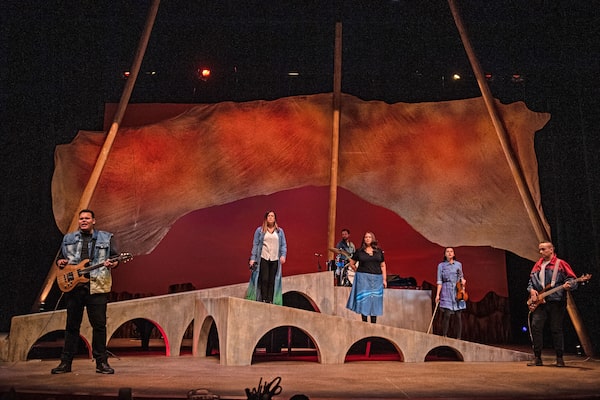
Reasonable Doubt performance at Persephone Theatre in Saskatoon, on Jan. 28, 2020.Liam Richards/Photo Electric Umbrella
- Title: Reasonable Doubt
- Written by: Joel Bernbaum, Lancelot Knight and Yvette Nolan
- Director: Yvette Nolan
- Actors: Kris Alvarez, Nathan Howe, Lancelot Knight, Krystle Pederson, Tara Sky, Colin Wolf
- Company: Persephone Theatre
- Venue: Rawlco Radio Hall at Persephone Theatre
- City: Saskatoon
Reasonable Doubt is a powerful and uncomfortable examination of the Colten Boushie tragedy and its aftermath – the shock of the verdict, its ugly implications for Indigenous people and the divisions that resulted.
On opening night in Saskatoon, the divisions were left behind and the audience came together in a special evening with emotion and resolve: This cannot continue.
Told by an ensemble cast of six reciting verbatim dialogue (complete with ums, uhs and stammers), from interviews and court documents, and performing a few musical numbers, Reasonable Doubt is dramatic, but not a straightforward re-enactment. It is more like a basket carefully woven with threads of disparate perspectives, opinions and court proceedings, creating a vessel strong enough to carry some heavy truths.
On Aug. 9, 2016, Boushie, a 22-year-old from the Cree Red Pheasant First Nation, was shot at close range and killed on a farm belonging to Gerald Stanley, a white man, who testified at his murder trial that the gun must have gone off by accident. Stanley was acquitted.
The show’s co-creator Joel Bernbaum conducted interviews with a wide range of Saskatchewanians about the case and race relations in the province, and pieced together the script with co-creators Lancelot Knight and Yvette Nolan using verbatim quotes from those interviews, as well as transcripts from the trial.
Six cast members, four of whom are Indigenous, play a variety of roles, transforming nimbly from characters such as the trial judge, to an elderly Indigenous woman to a school kid. This is never confusing, thanks to fine performances and clever staging: The character speaking is identified with their first name, race and decade of life projected onto the set’s backdrop, a screen of sorts made to look like animal skin in the shape of an open tepee.
Getting beyond the didactic kind of finger-waving that such a concept could easily slip into, the creators give it to us straight, including the barely disguised racism they encountered.
Boushie’s family sat in the front rows of the theatre on opening night, stoically listening as characters said things such as the Stanleys were minding their own business or those native kids were “boisterous.”
Or, more generally, “these people are not employable.”
At no point can the audience find refuge in the notion that this is only a play, only a script. Every line was actually spoken by someone Bernbaum interviewed.
This construct gives voice to questions many Canadians have had about this case. “How could you accidentally shoot someone in the head?” an Indigenous teen wonders.
Some of the awful details of that day are recounted: How Boushie’s body fell from the car; how his mother was callously informed of his death and then left alone. And a detail that never fails to enrage: That after Boushie was shot dead, Stanley’s wife put on a pot of coffee. The couple sat at the table with their son, Sheldon, drinking coffee in silence.
One of the play’s great successes is taking court transcripts – the testimony of Sheldon Stanley in this case – and juxtaposing them with comments from regular folk. They sat in silence? As one character put, that’s hard to believe; what they were doing at that kitchen table was getting their stories straight.
“As a mother, there’s a dead child in the vehicle,” an Indigenous woman in her 50s comments. How could she go inside for coffee and leave that boy to die alone? “I mean, who does that?”
This is one of the points where the cast breaks into a musical number. It’s not as weird as it sounds. The songs and music Knight has written, inspired by the transcripts, are for the most part very moving. This is the one aspect of Reasonable Doubt, however, that I found to be uneven, with some wobbly moments both in the writing and execution. I think that will improve with more performances.
Reasonable Doubt is structured in two acts, each about an hour long. The second act is no different from the first in staging, feel or approach – it is more of a continuation after what felt like an unnecessary cliffhanger. We are so immersed in this world – taking us out of it so we could grab a Coke and some popcorn didn’t serve the material.
I think this work would be more powerful played straight through; recognizing, of course, that some material would have to be sacrificed. Tightening it would not necessarily be bad; there is some repetition, and the ending threatened to fizzle.
To be clear, it did not. In its final minutes, Reasonable Doubt delivered more devastation.
One interviewee, an Indigenous man in his 60s, recalls going out for a drive after the Boushie killing. “My wife says to me: pull over somewhere. But not in a farmyard.”
Or the sweet 10-year-old Indigenous child whose dad tells him not worry about his prospects; that he’s a good boy. You can imagine little Colten being told the same thing by his mom.
“These negatives stories are killing us,” another Indigenous person says. Stories are that powerful; they have the ability to destroy. But also to give life. This is one of those stories.
Reasonable Doubt runs at Persephone Theatre until Feb. 12.
 Marsha Lederman
Marsha Lederman